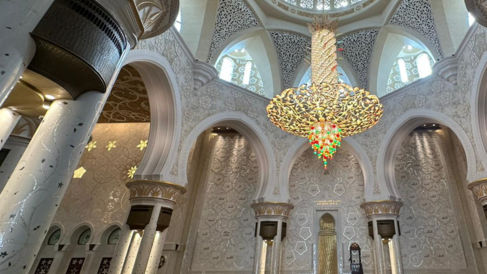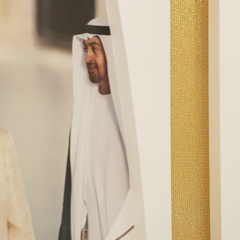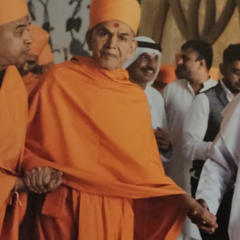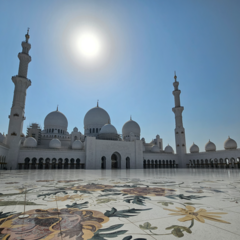
Tilak Parekh is a postgraduate research student in the Faculty of Divinity. His doctoral thesis focuses on the purpose, creation and impact of the Neasden Temple in northwest London—the first traditional Hindu temple built in the western world. Visiting another famous religious site this summer, he was drawn to reflect:
“Earlier this month [August], I went to see the Sheikh Zayed Grand Mosque in Abu Dhabi, the capital city of the United Arab Emirates. It is the largest and most prominent mosque in the country. To reach the mosque, one has to walk through an extensive underground tunnel. The walls of this tunnel serve as a beautiful and meaningful preface to the structure you are about to set your eyes upon.

“Pithy headings and large images amidst the royal white-and-gold colour scheme gently inculcate the spiritual ethos of the mosque into the minds of the millions of visitors and worshippers who pass through every year. Evocative headings such as ‘Humanity is our message to the world’ and ‘The Meeting Point of Cultures’ combine with images of an array of high-profile visitors (including Queen Elizabeth II, King Charles III, and Pope Francis). A visitor quickly appreciates the stature and the message of the place one is about to enter.
“Amidst these visuals, there is a photograph of Mahant Swami Maharaj. He is a global Hindu guru of the BAPS Swaminarayan tradition who is leading the creation of the first traditional Hindu temple in the UAE. Seeing his image was both surprising and inspiring. Surprising, because I did not expect to see an image of a Hindu guru dressed in orange robes in the chief mosque of a Muslim country. Inspiring, because for me, it was a clear, striking mark of interfaith respect and appreciation.

“On seeing this image, Hindus, for whom a mosque may be a somewhat foreign space, could suddenly feel a sense of acceptance or even affinity. Consequently, the stream of visitors to this global attraction would subtly receive a positive message of interfaith harmony, a theme that is recently being highlighted in the region, for example, through the creation of the Abrahamic Family House and BAPS Hindu Mandir.
“After this preamble within the cool air-conditioned tunnel, I went up the escalators to be suddenly hit by the intense heat, at which moment I saw the mosque.
“The mosque was simply beautiful. The colours, designs, and materials all came together to form a tapestry that was a treat for the eyes. Awe-struck, I stood there for a few minutes in silence. I bracketed out the conceptual categories that my mind continually generates from my research and I decided to just feel.

Inner feelings
“Buildings do not only generate streams of structural thoughts, for instance, the type that appears on an architect’s drawing plan. They also create and nurture inner feelings. I felt something. I wanted to take in the building and absorb its ethos in such a manner that I would remain unadulterated by any active thoughts from my readings.
“As I stood in the grounds of the mosque, I felt a sense of awe, majesty, and, true to its name, grandeur seep into me. Despite the hustle and bustle, and the relentless chatter of tourists, there was yet a deep sense of silence.
“I am not a Muslim . . .
“… in the sense that my religious subjectivity is not rooted in Islamic theology, nor do I have any immediate cultural connections to the faith. And yet, I did feel something.
“It was as if I was being gently draped in a blanket of tranquility. Without any knowledge of the history, composition, structure, and symbolism of the mosque, simply the act of standing within its precincts generated a feeling of finitude deep inside me.
“Those moments inside the Grand Mosque reinforced the idea developed by Robert Brenneman and Brian Miller that ‘buildings speak’; the stones, the cement, and the calligraphy in a mosque can speak to us as clearly as the tourists passing through the place. Buildings, in their very physical structure, have an evocative power – if only we care to listen.”
Further reading
Robert Brennemann & David Miller, Building Faith: A sociology of religious structures (Oxford: Oxford University Press, 2020).
More about Tilak
Tilak’s research interests span sacred space, religious leadership, youth religiosity, and digital religion. He has a degree in Theology and Religion from Oxford where he focused on Christianity, followed by an MPhil at Cambridge and an MSc in Social and Cultural Anthropology at UCL. Through his study of theology and anthropology, he engages in both intra-faith research in the Hindu community as well as in initiatives for inter-faith research. He is a member of the Cambridge Interfaith Research Forum.
All photographs were taken by Tilak and shared here with his permission.
